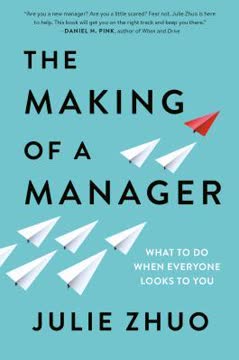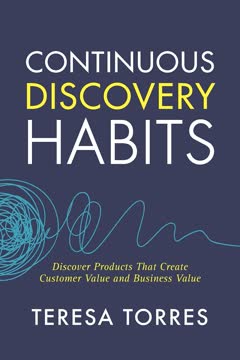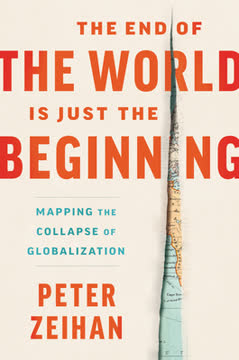Key Takeaways
1. Redefine innovation: Focus on customer jobs and outcomes, not solutions
Customers buy products and services to help them get jobs done.
Jobs-to-be-done framework. Innovation should focus on understanding the fundamental jobs customers are trying to accomplish and the outcomes they use to measure success. This shifts the focus from product features to customer needs. By identifying jobs and outcomes, companies can create solutions that deliver real value.
Outcome-driven innovation. Instead of asking customers what products they want, companies should uncover the metrics customers use to define success when getting a job done. These desired outcomes are stable over time and provide a clear target for innovation efforts. By focusing on improving customers' ability to achieve their desired outcomes, companies can create breakthrough products and services.
- Examples of jobs: Cut wood (circular saw), manage music (iPod), limit financial risk (insurance)
- Examples of outcomes: Minimize the likelihood of the cut going off track, increase the percentage of plants that emerge at the same time, minimize the time it takes to look up a needed phone number
2. Capture the right customer inputs: Jobs, outcomes, and constraints
The literal voice of the customer sidetracks the innovation process because customers are not qualified to know what solutions are best—that is the job of the organization.
Three key inputs. To innovate effectively, companies need to capture three types of customer inputs:
- Jobs customers are trying to get done
- Outcomes customers use to measure success
- Constraints that prevent customers from adopting or using a product
Avoid common pitfalls. Traditional "voice of the customer" approaches often capture the wrong inputs, such as product solutions, specifications, or vague needs statements. These lead companies astray. Instead, focus on capturing desired outcomes in a specific format: direction of improvement + unit of measure + what is desired.
- Example job: Clean teeth
- Example outcome: Minimize the time it takes to remove food from hard-to-reach places
- Example constraint: Shaky hands making it difficult to use a blood glucose meter
3. Identify opportunities by prioritizing underserved outcomes
An opportunity for improvement exists when an important outcome is underserved—that is, when it has a high opportunity score.
Opportunity algorithm. To identify the best opportunities for innovation, use the formula: Opportunity = Importance + (Importance - Satisfaction). This reveals which outcomes are both important to customers and not well satisfied by current solutions.
Prioritize opportunities. Use quantitative research to rate the importance and current satisfaction level for each outcome. Then apply the opportunity algorithm to prioritize:
- Scores >15: Extreme opportunities
- Scores 12-15: Low-hanging fruit
- Scores 10-12: Worth consideration
- Scores <10: Unattractive
By focusing on the highest-scoring opportunities, companies can direct innovation efforts where they will create the most value for customers.
4. Segment markets based on underserved outcomes, not demographics
The only way to find a group of customers with a set of underserved outcomes is to use that variable as a means for segmentation.
Outcome-based segmentation. Traditional market segmentation based on demographics or psychographics often fails to reveal true innovation opportunities. Instead, segment markets based on groups of customers with similar sets of underserved outcomes. This uncovers "segments of opportunity" that are ripe for innovation.
Benefits of outcome-based segmentation:
- Identifies unique opportunities in mature markets
- Discovers demanding segments willing to pay more
- Reveals overserved segments for potential disruption
- Determines best market entry points
- Uncovers high-growth potential segments
By segmenting based on outcomes, companies can develop targeted solutions that address specific customer needs, rather than trying to create one-size-fits-all products.
5. Target opportunities strategically for growth and innovation
An effective targeting strategy adds function and performance (but not necessarily cost) in areas that are underserved and reduces cost and function in areas that are overserved.
Strategic targeting. After identifying opportunities and segments, companies must decide which to pursue. Effective targeting strategies include:
- Addressing broad market opportunities first
- Targeting related opportunities that form a theme
- Pursuing unrelated opportunities that represent growth avenues
- Creating new ancillary products for big single opportunities
- Reducing costs in overserved areas
Balancing value and cost. The goal is to optimize products by adding value where customers need it most while eliminating unnecessary costs. This creates a unique and valued competitive position.
- Example: Coloplast targeted underserved outcomes related to "preventing complications" in wound care, leading to double-digit growth
- Example: Bosch targeted multiple unrelated opportunities in circular saws, creating a breakthrough product
6. Position products by connecting features to underserved outcomes
The messaging strategy that is most effective clearly states a product's advantage in areas of the market that are highly underserved.
Outcome-based messaging. To effectively communicate product value, connect specific product features to the underserved outcomes they address. This precision helps customers understand the true benefits of the product.
Balancing function and emotion. Consider the product's functional complexity and emotional appeal when developing messaging:
- Low function, low emotion: Focus on service or cost (e.g., raw materials)
- Low function, high emotion: Emphasize emotional appeal (e.g., cosmetics)
- High function, high emotion: Balance both (e.g., cars, clothing)
- High function, low emotion: Focus on functional benefits (e.g., medical devices)
Outcome-based branding. Create brands that connect products to the jobs customers are trying to accomplish. This makes customers think of the product whenever they need to get that job done.
- Example: Milwaukee's "Sawzall" brand for reciprocating saws
7. Prioritize development projects based on addressing key opportunities
Products that deliver less than 3 percent more value than those currently available often fail.
Evaluate pipeline projects. Assess how well each project in the development pipeline addresses targeted underserved outcomes. This allows companies to:
- Identify which projects will create the most customer value
- Accelerate high-potential projects
- Modify or kill low-value projects
- Reduce wasted development resources
Customer scorecard. Use a scorecard listing all customer outcomes to objectively evaluate how much value each project delivers. Successful new products typically deliver 5-10% more value than current offerings, while breakthrough products deliver 20%+ more value.
- Example: Cordis Corporation prioritized stent development after recognizing it addressed a key underserved outcome, leading to a billion-dollar business
8. Generate breakthrough concepts through focused brainstorming
Companies do not need to generate hundreds of ideas; they need to generate just a handful of ideas that specifically and satisfactorily address their customers' underserved outcomes.
Focused brainstorming. Traditional brainstorming often produces many irrelevant ideas. Instead, use focused brainstorming:
- Stay focused on targeted underserved outcomes
- Aim for breakthrough improvement (80%+ satisfaction)
- Apply constraints to enhance creativity
- Eliminate bad ideas quickly
- Optimize best ideas for cost, effort, risk, and sustainability
Targeted ideation. By focusing creativity on specific underserved outcomes, companies can generate fewer but higher-quality ideas that are more likely to create customer value.
- Example: Bosch circular saw team constrained to add features without increasing cost, leading to innovative airflow redirection solution
9. Evaluate ideas objectively using the customer scorecard
In an outcome-driven environment, company team members, not customers, objectively judge proposed new products by determining the degree to which the proposed offering satisfies all the possible customer outcomes and quantifying the total value the offering delivers.
Customer scorecard evaluation. Evaluate new product concepts objectively by assessing how well they satisfy all customer outcomes, not just a few. This provides a quantitative measure of potential value creation.
Benefits of scorecard evaluation:
- Predicts product success before development
- Compares concepts objectively
- Identifies weaknesses in concepts for improvement
- Eliminates subjective opinions and politics from decision-making
By using the customer scorecard, companies can confidently select winning concepts and avoid investing in ideas unlikely to succeed in the market.
10. Transform innovation into a predictable, systematic process
To achieve this level of certainty, a company must not only determine whether or not a product idea will deliver customer value, the company must also know how much more value it will deliver than the products and services it is competing with.
Systematic innovation process. By following the outcome-driven approach, companies can transform innovation from an unpredictable art to a systematic, manageable process:
- Define innovation strategy
- Capture customer inputs (jobs, outcomes, constraints)
- Identify opportunities
- Segment markets
- Target opportunities
- Position current products
- Prioritize development projects
- Generate breakthrough concepts
- Evaluate ideas objectively
- Implement winning solutions
Measurable results. This approach allows companies to quantify the potential value of new concepts, predict success rates, and make data-driven decisions throughout the innovation process. It reduces risk, accelerates time-to-market, and increases the likelihood of creating breakthrough products and services.
- Example: Pratt & Whitney used this process to develop a solution that increased customer satisfaction by 35%, regained lost market share, and captured additional growth
Last updated:
FAQ
1. What’s "What Customers Want" by Anthony W. Ulwick about?
- Outcome-Driven Innovation Framework: The book introduces and explains the Outcome-Driven Innovation (ODI) methodology, a systematic approach to creating breakthrough products and services by focusing on the outcomes customers want to achieve.
- Moving Beyond Customer-Driven: Ulwick critiques traditional customer-driven approaches and argues for a shift toward understanding the "jobs" customers are trying to get done and the metrics they use to measure success.
- Eight-Step Process: The book outlines an eight-step process for innovation, from formulating strategy to generating and evaluating new concepts, all centered on customer outcomes.
- Practical Application: Through case studies and real-world examples, Ulwick demonstrates how companies can apply ODI to reduce failure rates and consistently deliver products customers truly value.
2. Why should I read "What Customers Want" by Anthony W. Ulwick?
- Predictable Innovation Success: The book offers a proven, structured method to make innovation less random and more predictable, addressing the high failure rates of new products.
- Actionable Tools and Techniques: Readers gain practical tools for gathering customer insights, prioritizing opportunities, and aligning product development with real customer needs.
- Applicable Across Industries: The ODI approach is relevant for companies in any sector—product, service, B2B, or B2C—seeking growth or market leadership.
- Challenge to Conventional Wisdom: Ulwick’s critique of the "voice of the customer" paradigm encourages readers to rethink how they approach customer research and product development.
3. What are the key takeaways from "What Customers Want" by Anthony W. Ulwick?
- Focus on Customer Outcomes: Successful innovation starts by identifying the jobs customers want to get done and the outcomes they use to measure success, not by asking for feature requests.
- Systematic Process: Innovation can be managed like any other business process by following Ulwick’s eight-step ODI framework.
- Prioritization is Critical: Not all customer needs are equal; the best opportunities are those that are both important and underserved.
- Segmentation by Outcomes: Traditional demographic or needs-based segmentation is less effective than segmenting customers by the outcomes they struggle to achieve.
4. How does the Outcome-Driven Innovation (ODI) method by Anthony W. Ulwick work?
- Jobs, Outcomes, Constraints: ODI starts by identifying the functional, personal, and social jobs customers are trying to get done, the outcomes they desire, and any constraints they face.
- Quantitative Prioritization: Customer outcomes are rated for importance and satisfaction, and an "opportunity algorithm" is used to identify where the biggest gaps—and thus opportunities—exist.
- Segmentation and Targeting: Markets are segmented based on clusters of underserved outcomes, allowing for precise targeting of innovation efforts.
- Idea Generation and Evaluation: Focused brainstorming is used to generate solutions for high-opportunity outcomes, and a customer scorecard quantifies the value of new concepts before development.
5. What are the main differences between the traditional customer-driven approach and the Outcome-Driven Innovation approach in "What Customers Want"?
- Type of Input: Traditional approaches rely on customer-stated needs, solutions, or specifications, while ODI seeks to uncover the underlying outcomes customers use to judge success.
- Language and Precision: ODI emphasizes a common, precise language (jobs, outcomes, constraints) to avoid ambiguity and misinterpretation.
- Process Discipline: The ODI method treats innovation as a repeatable, measurable process, rather than an art or a series of creative guesses.
- Predictability: By focusing on quantifiable outcomes, ODI increases the predictability of innovation success compared to the trial-and-error nature of customer-driven methods.
6. What are the eight steps of the Outcome-Driven Innovation process in "What Customers Want"?
- Formulate Innovation Strategy: Decide what type of innovation to pursue and who in the value chain to target.
- Capture Customer Inputs: Gather data on jobs, outcomes, and constraints, not just wants or feature requests.
- Identify Opportunities: Use quantitative methods to find which outcomes are important and underserved.
- Segment the Market: Group customers by shared underserved outcomes to find segments of opportunity.
- Target Opportunities for Growth: Select which opportunities to pursue for maximum value creation.
- Position Current Products: Align messaging and branding with the outcomes your products already address.
- Prioritize Projects in the Pipeline: Evaluate and fund initiatives that best address targeted outcomes.
- Devise Breakthrough Concepts: Use focused brainstorming and customer scorecards to generate and validate new ideas.
7. How does "What Customers Want" by Anthony W. Ulwick define and use the concept of "jobs to be done"?
- Jobs as the Unit of Analysis: Customers buy products and services to get specific jobs done, which can be functional, personal, or social.
- Beyond Demographics: Focusing on jobs shifts attention from who the customer is to what they are trying to accomplish.
- Growth Opportunities: Identifying ancillary or related jobs can reveal new avenues for innovation and market expansion.
- Stable Over Time: Jobs tend to remain stable, providing a reliable foundation for long-term innovation strategy.
8. How does "What Customers Want" by Anthony W. Ulwick recommend identifying and prioritizing innovation opportunities?
- Importance and Satisfaction Ratings: Customers rate each outcome for importance and current satisfaction, creating a data-driven basis for opportunity identification.
- Opportunity Algorithm: The formula (Opportunity = Importance + max(Importance – Satisfaction, 0)) highlights outcomes that are both important and underserved.
- Underserved vs. Overserved: High-opportunity scores indicate areas ripe for improvement, while overserved outcomes suggest where cost can be reduced.
- Avoiding Common Mistakes: The method helps companies avoid improving already satisfied outcomes or focusing on unimportant ones.
9. What is outcome-based market segmentation, and why does "What Customers Want" by Anthony W. Ulwick argue it’s superior?
- Segments of Opportunity: Outcome-based segmentation groups customers by the specific outcomes they find underserved, rather than by demographics or product usage.
- Homogeneity and Predictability: These segments are more homogeneous in their needs, making them more predictable targets for innovation.
- Revealing Hidden Markets: This approach can uncover new or overlooked segments, including those suitable for disruptive innovation.
- Actionable Insights: Segmentation by outcomes directly informs product development, messaging, and go-to-market strategies.
10. How does "What Customers Want" by Anthony W. Ulwick advise companies to generate and evaluate new product ideas?
- Focused Brainstorming: Idea generation is directed at specific, high-opportunity outcomes, rather than being a scattershot process.
- Quality Over Quantity: The goal is a handful of high-value ideas, not hundreds of unfocused suggestions.
- Customer Scorecard: New concepts are evaluated against all targeted outcomes, quantifying the value they deliver before development begins.
- Iterative Improvement: The process encourages refining ideas to maximize value, minimize cost, and ensure sustainability.
11. What are the most common pitfalls in innovation that "What Customers Want" by Anthony W. Ulwick helps companies avoid?
- Vague Customer Inputs: Relying on ambiguous needs, solutions, or benefits instead of precise outcomes leads to misaligned products.
- Misallocated Resources: Without clear prioritization, companies waste resources on low-value or overserved outcomes.
- Ineffective Segmentation: Traditional segmentation can create "phantom segments" that don’t reflect real opportunities.
- Failure to Kill Bad Projects: The ODI process provides objective criteria for stopping projects that won’t deliver customer value.
12. What are the best quotes from "What Customers Want" by Anthony W. Ulwick and what do they mean?
- “Customers buy products and services to help them get jobs done.”
This quote encapsulates the core of ODI: focus on the job, not the customer’s stated wants. - “The literal voice of the customer does not translate into meaningful inputs.”
Ulwick warns that simply listening to customer requests often leads to the wrong product decisions. - “Innovation is a science—a systematic process for creating products or services that delivers new value to customers—and not an art form that is forever destined to produce random and unpredictable results.”
This challenges the myth that innovation is inherently unpredictable, advocating for a disciplined, process-driven approach. - “Only after knowing what jobs customers are trying to get done and what outcomes they are trying to achieve are companies able to systematically and predictably identify opportunities and create products and services that deliver significant new value.”
This quote summarizes the book’s thesis: understanding jobs and outcomes is the foundation for successful, repeatable innovation.
Review Summary
What Customers Want receives mixed reviews. Many praise its innovative approach to product development, focusing on customer outcomes rather than traditional methods. Readers find the concept valuable for product managers and innovators. However, some criticize the book for being repetitive, self-promotional, and lacking practical implementation details. Critics argue it rehashes old ideas and serves as a marketing tool for the author's consulting services. Despite these critiques, many readers appreciate the book's insights on understanding customer needs and improving product development processes.
Similar Books









Download PDF
Download EPUB
.epub digital book format is ideal for reading ebooks on phones, tablets, and e-readers.





